Are you curious about the calorie content of a 14 oz steak? Let’s uncover the facts and figures. In this section, we will dive into the specific calorie count of a 14 oz steak and explore the nutritional value of this popular meat. Discover how many calories are packed into this meaty delight.
- A 14 oz boneless, cooked steak contains approximately 1000 calories.
- The breakdown of calories in a 14 oz steak is 55% fat, 0% carbs, and 45% protein.
- A 3 oz boneless, cooked ribeye steak contains about 199 calories, 10.8g of fat, and 23.8g of protein.
- Beef provides high-quality protein, iron, and vitamin B12, which are important for various bodily functions.
- It is recommended to limit saturated fat intake and choose lean cuts of red meat for a healthy eating pattern.
Understanding the Calorie Content of a 14 oz Steak
Before indulging in a juicy 14 oz steak, it’s important to understand its calorie content and nutritional composition. A 14 oz boneless, cooked steak contains approximately 1000 calories, according to a food database and calorie counter. This serving size also provides 59.58g of fat, 0g of carbohydrates, and 108.31g of protein. The breakdown of calories is 55% fat, 0% carbs, and 45% protein.
To further explore the nutritional value of a 14 oz steak, let’s take a look at other common serving sizes. The same source provides calorie information for different cuts of steak. For example, a 4 oz serving of sirloin steak contains about 287 calories, while an 8 oz serving of filet mignon contains around 572 calories. It’s important to note that these numbers can vary based on the cooking method and preparation.
Now, let’s focus on a specific cut of steak – the ribeye. According to another source, a 3 oz boneless, cooked ribeye steak contains approximately 199 calories, 10.8g of fat, and 23.8g of protein. This flavorful steak is also a good source of iron and zinc, which are important for overall health and well-being.
| Serving Size | Calories | Fat (g) | Protein (g) |
|---|---|---|---|
| 14 oz | 1000 | 59.58 | 108.31 |
| 4 oz Sirloin | 287 | 15.04 | 30.56 |
| 8 oz Filet Mignon | 572 | 41.87 | 46.05 |
| 3 oz Ribeye | 199 | 10.8 | 23.8 |
While beef can be a source of essential nutrients and high-quality protein, it’s important to consider the overall composition of your diet. Some studies suggest that moderate portions of beef, like a ribeye steak, can be included in a healthy eating pattern. However, it is recommended to limit saturated fat intake and choose lean cuts of red meat. When purchasing beef, factors such as the grade and feeding method (grain-fed or grass-fed) can also impact its nutritional profile.
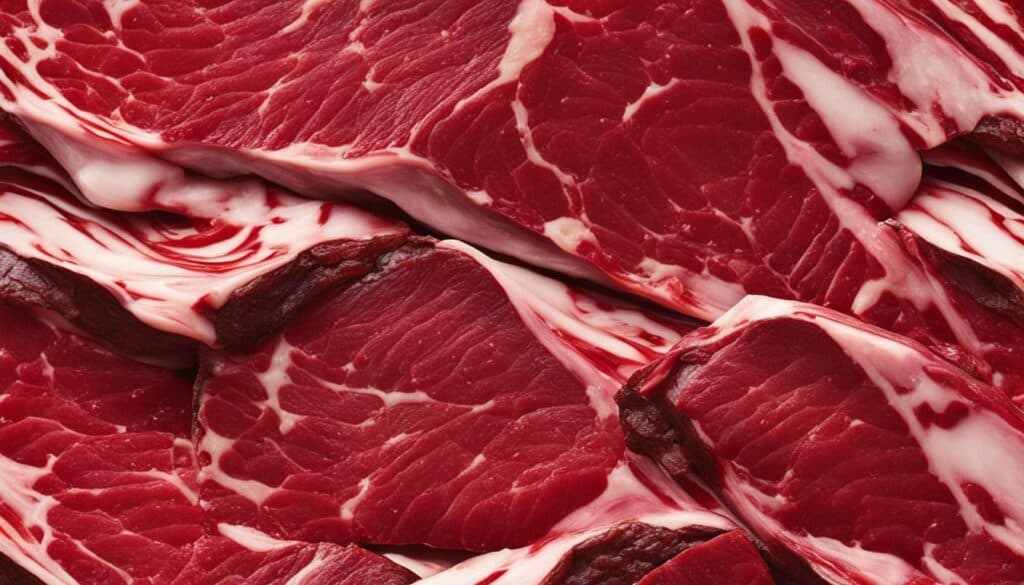
It’s always wise to consult with a healthcare provider or registered dietitian to tailor your diet to your specific needs and goals. By understanding the calorie content and nutritional value of a 14 oz steak, you can make informed choices that align with your overall well-being.
The Breakdown: Fat, Carbohydrates, and Protein in a 14 oz Steak
Let’s take a closer look at the breakdown of fat, carbohydrates, and protein in a 14 oz steak. According to a food database and calorie counter, a 14 oz boneless, cooked steak contains approximately 1000 calories. This serving size also provides 59.58g of fat, 0g of carbohydrates, and 108.31g of protein. The breakdown of calories is 55% fat, 0% carbs, and 45% protein.
| Nutrient | Amount per 14 oz serving |
|---|---|
| Calories | 1000 |
| Fat | 59.58g |
| Carbohydrates | 0g |
| Protein | 108.31g |
This nutritional breakdown highlights the high protein content in a 14 oz steak, making it a good choice for those looking to meet their protein needs. However, it is important to note that the fat content is relatively high, constituting the majority of the calorie count. This can be attributed to the marbling in the meat, which adds flavor but also increases the fat content.
While the absence of carbohydrates in a 14 oz steak may appeal to those following low-carb or ketogenic diets, it’s crucial to consider the overall balance of your meals to ensure a well-rounded intake of nutrients. Incorporating other food groups, such as vegetables and whole grains, can provide important vitamins, minerals, and fiber that may be lacking in a steak-centric meal.
Remember, moderation is key when consuming red meat, as excessive intake of saturated fat, such as that found in steak, has been linked to various health concerns. Choosing lean cuts of red meat and balancing your overall diet with a variety of other nutrient-rich foods can help maintain a healthy eating pattern.
Sources: food database and calorie counter, nutrition experts.
Comparing 14 oz Steak to Other Serving Sizes
Curious about how a 14 oz steak stacks up against other serving sizes? Let’s explore the calorie differences between various steak portion sizes.
When it comes to enjoying a juicy steak, portion size plays a crucial role in determining your calorie intake. While a 14 oz steak may sound tempting, it’s important to consider how it compares to other common serving sizes.
To put things into perspective, let’s take a look at the calorie content of different steak portions:
| Steak Portion Size | Calories |
|---|---|
| 8 oz | approximately 600-800 calories |
| 6 oz | approximately 450-600 calories |
| 4 oz | approximately 300-400 calories |
As you can see, a 14 oz steak can pack quite a caloric punch compared to smaller portions. It’s worth noting that the calorie count can vary depending on the cut and preparation method, so it’s always a good idea to check the nutritional information for the specific type of steak you’re enjoying.
Remember, moderation and balance are key when it comes to maintaining a healthy eating pattern. Enjoying a delicious steak is not off-limits, but it’s important to be mindful of portion sizes and make choices that align with your overall calorie and nutrition goals.
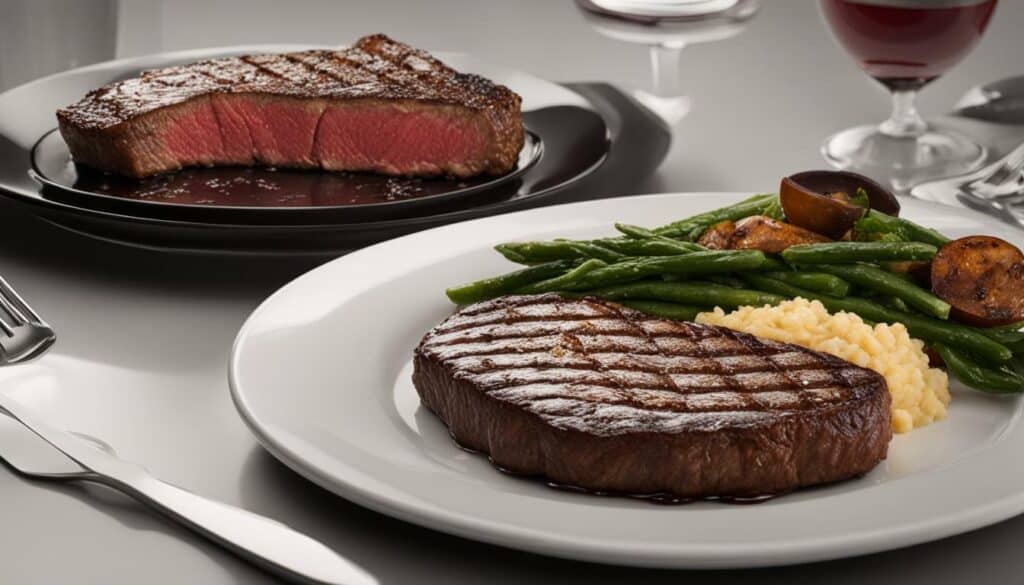
If you’re a fan of ribeye steak, find out the specific nutritional value of a 3 oz serving.
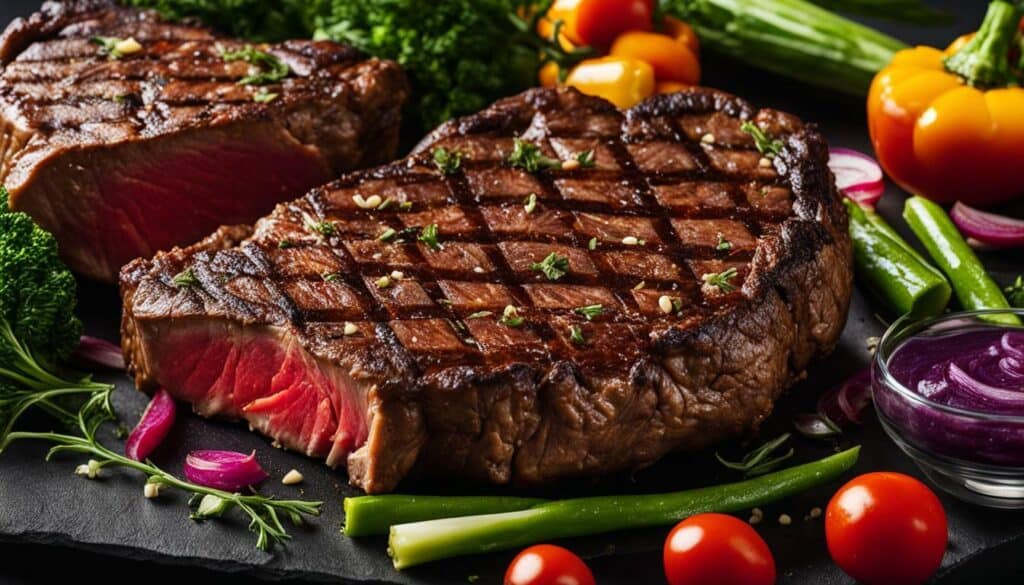
According to a food database and calorie counter, a 3 oz serving of boneless, cooked ribeye steak contains approximately 199 calories. This delectable cut of meat also provides 10.8g of fat and 23.8g of protein. Ribeye steak is known for its marbling, which contributes to its tenderness and rich flavor.
Not only is ribeye steak a delicious treat, but it also offers important nutrients. This cut is a good source of iron, which is necessary for carrying oxygen throughout the body and maintaining energy levels. It also provides zinc, a mineral that supports immune function, wound healing, and DNA synthesis.
| Nutrient | Amount per 3 oz serving |
|---|---|
| Calories | 199 |
| Fat | 10.8g |
| Protein | 23.8g |
| Iron | N/A |
| Zinc | N/A |
It’s important to note that the nutritional content of ribeye steak may vary depending on factors such as the cut of meat, cooking method, and portion size. This information is based on a general 3 oz serving of boneless, cooked ribeye steak.
To enjoy the nutritional benefits of ribeye steak while also maintaining a healthy eating pattern, it is recommended to choose lean cuts of red meat and consume them in moderation. Additionally, be mindful of the saturated fat content, as excessive intake can contribute to cardiovascular health issues. Incorporating a variety of nutrient-rich foods, such as fruits, vegetables, whole grains, and lean proteins, into your diet can help ensure a well-rounded and balanced approach to nutrition.
The Debate: Health Implications of Beef Consumption
The debate regarding the health implications of beef consumption continues to spark discussions. Let’s explore different perspectives on including steak in a balanced diet.
One perspective argues that moderate portions of beef, such as a 14 oz steak, can be part of a healthy eating pattern. Beef is known for its high-quality protein content, which can aid in weight management and muscle retention. It is also a good source of essential nutrients like iron and vitamin B12, which play a crucial role in various bodily functions.
However, it is important to consider the potential risks associated with consuming red meat. Some studies have linked red meat consumption to an increased risk of chronic inflammatory diseases. This has led to recommendations to limit saturated fat intake and choose lean cuts of red meat.
When it comes to meat allergies, although rare, they can occur. If symptoms arise, it is advisable to consult with a healthcare provider for appropriate guidance and support.
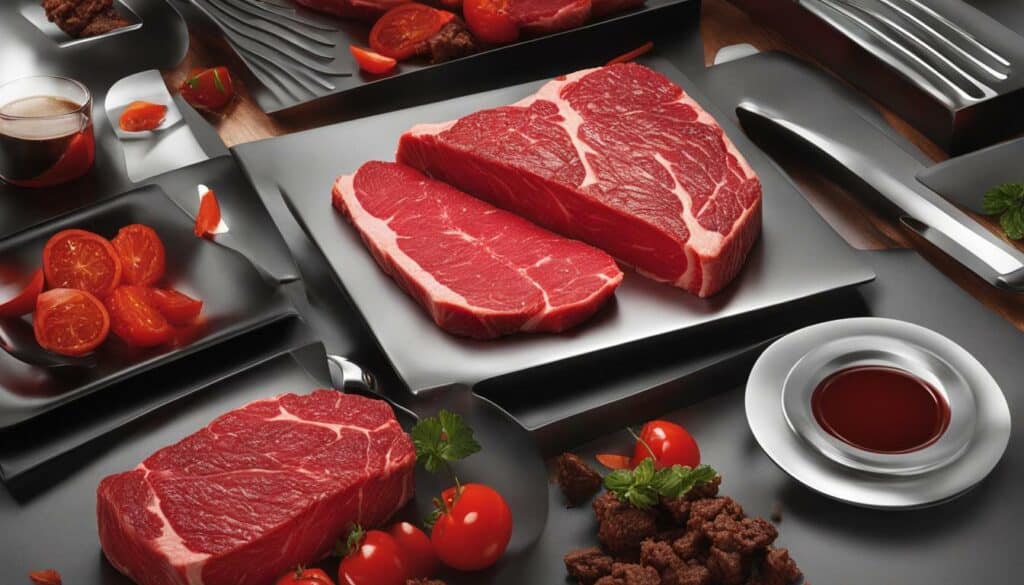
In summary, the nutritional value of a 14 oz steak includes high protein content but can also be high in fat. The debate on whether to include steak in a healthy eating pattern continues. It is recommended to be mindful of saturated fat intake and choose lean cuts of red meat. When purchasing beef, consider factors such as the grade and the feeding method.
Considerations for a Healthy Eating Pattern
To maintain a healthy eating pattern, it’s important to consider a few key factors when consuming steak and other cuts of red meat. While beef can provide essential nutrients like high-quality protein, iron, and vitamin B12, it’s also important to be mindful of saturated fat intake and choose lean cuts. By making informed choices, you can enjoy the nutritional benefits of beef while maintaining a balanced diet.
Choose Lean Cuts
When purchasing steak, opt for lean cuts to minimize saturated fat intake. Lean cuts include sirloin, tenderloin, and flank steak. These cuts generally have less marbling and lower fat content compared to ribeye or T-bone steaks. Trimming visible fat before cooking can also help reduce overall fat content.
Monitor Portion Sizes
While steak can be a delicious and satisfying part of a meal, it’s important to control portion sizes to manage calorie and fat intake. A 14 oz steak, for example, contains around 1000 calories and 59.58g of fat. Consider sharing a larger serving with a dining companion or choosing a smaller portion size to limit calorie intake. Alternatively, balance the meal with a variety of vegetables and whole grains to create a well-rounded plate.
Consider Feeding Methods
When it comes to beef, consider the feeding method of the cattle. Grain-fed beef tends to have more marbling and higher fat content compared to grass-fed beef. Grass-fed beef is often leaner and may provide a slightly different nutritional profile. Choosing grass-fed beef can be a way to reduce saturated fat intake and increase the omega-3 fatty acid content in your diet.
Balancing Health and Enjoyment
It’s important to strike a balance between enjoying the flavors and textures of steak while maintaining a healthy eating pattern. Incorporate a variety of protein sources into your diet, including lean cuts of red meat, poultry, fish, legumes, and plant-based proteins. By focusing on portion control, choosing lean cuts, and balancing your overall diet, you can savor the taste of a delicious steak while nourishing your body.
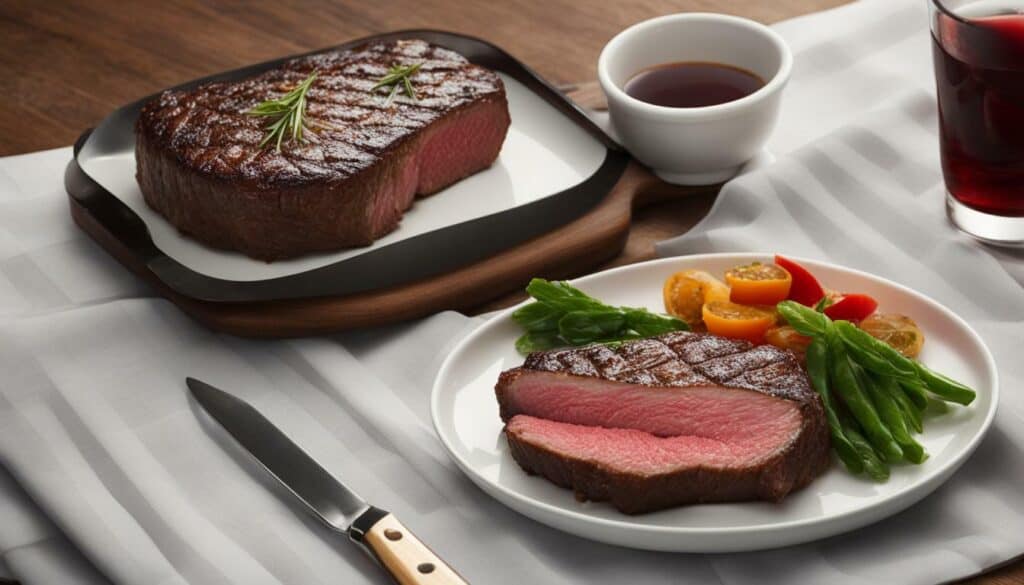
Beef is more than just a tasty protein source. Discover the nutritional benefits it provides, including high-quality protein, iron, and vitamin B12. These nutrients are essential for maintaining a healthy body and supporting various bodily functions.
Protein is a crucial component of a balanced diet, and beef is an excellent source of high-quality protein. Protein plays a vital role in muscle growth and repair, making it essential for athletes and individuals who engage in regular physical activity. It also helps to keep you feeling full and satisfied, making it beneficial for weight management.
In addition to protein, beef is rich in iron, a mineral that is essential for the production of red blood cells. Iron helps transport oxygen throughout the body, supporting energy levels and maintaining overall health. Including iron-rich foods like beef in your diet can help prevent iron deficiency anemia.
Vitamin B12 is another important nutrient found in beef. It is necessary for the formation of red blood cells, nerve function, and DNA synthesis. Vitamin B12 is primarily found in animal-based foods, making beef an excellent choice for individuals following a omnivorous diet. Adequate intake of vitamin B12 is crucial for maintaining proper brain function and overall well-being.
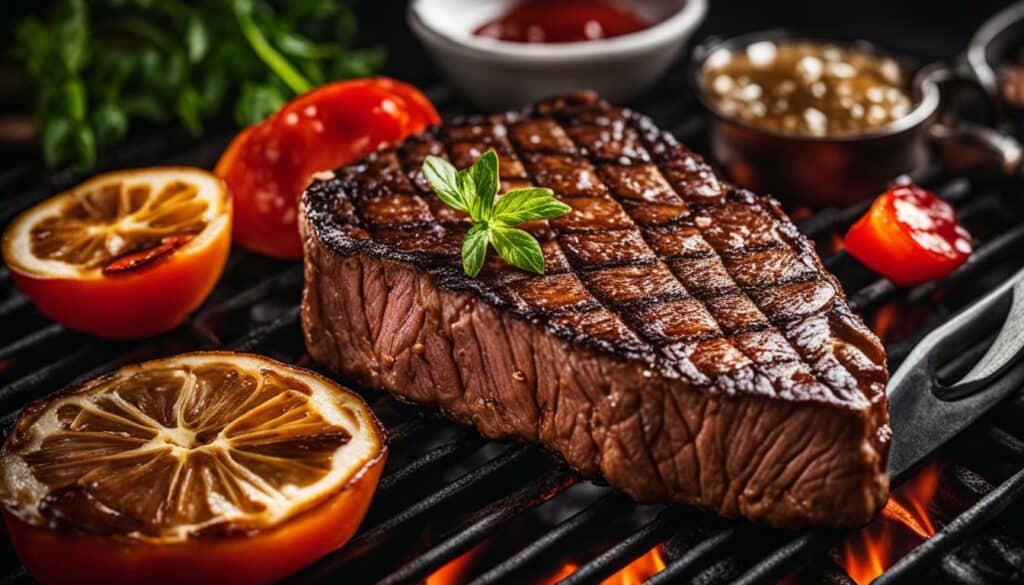
| Nutrient | Average Amount per 3 oz serving of Beef |
|---|---|
| Calories | 199 |
| Total Fat | 10.8g |
| Protein | 23.8g |
While beef offers many nutritional benefits, it’s important to keep in mind that moderation and choosing lean cuts are key. Opting for lean cuts of beef can help reduce saturated fat intake, which is linked to an increased risk of heart disease. It’s also essential to consider factors such as the grade and feeding method when purchasing beef. Grass-fed beef, for example, may contain higher levels of certain nutrients, such as omega-3 fatty acids.
In conclusion, beef provides high-quality protein, iron, and vitamin B12, making it a valuable addition to a balanced diet. When consumed in moderation and paired with a variety of other nutritious foods, beef can contribute to overall health and well-being.
Potential Health Risks and Allergies
While red meat can provide valuable nutrients, it’s important to be aware of potential health risks and the rare occurrence of meat allergies. Some studies have linked high consumption of red meat, including steak, to an increased risk of chronic inflammatory diseases such as heart disease and certain types of cancer. These risks are thought to be associated with the high saturated fat content in red meat, which can raise levels of LDL cholesterol and contribute to the development of plaque in the arteries.
It’s also essential to note that meat allergies, although rare, can occur. According to the American Academy of Allergy, Asthma & Immunology, meat allergies are most commonly triggered by the alpha-gal sugar found in mammalian meat, including beef. Symptoms of a meat allergy usually manifest a few hours after consumption and may include hives, itching, swelling, digestive issues, and, in severe cases, anaphylaxis. If you experience any of these symptoms after eating meat, it is crucial to seek medical advice for further evaluation and diagnosis.
To mitigate potential health risks and minimize the chance of allergic reactions, it is recommended to practice moderation when consuming red meat, including steak. Opt for lean cuts of beef, such as sirloin or tenderloin, which are lower in saturated fat. Additionally, it is advised to incorporate a variety of other protein sources, such as poultry, fish, legumes, and plant-based alternatives, into your diet to ensure a well-rounded nutrient intake.
| Type of Meat | Calories per 3 oz serving | Fat per 3 oz serving | Protein per 3 oz serving |
|---|---|---|---|
| Ribeye Steak (boneless, cooked) | 199 | 10.8g | 23.8g |
| Sirloin Steak (boneless, cooked) | 180 | 7.8g | 25.2g |
| Tenderloin Steak (boneless, cooked) | 166 | 7.5g | 23.9g |
Conclusion
We’ve uncovered the calorie count and nutritional value of a 14 oz steak, explored the health implications of beef consumption, and considered the benefits and potential risks. Now, armed with knowledge, you can make informed choices about including steak in your diet.
Factual data reveals that a 14 oz boneless, cooked steak contains approximately 1000 calories, with 55% of those calories coming from fat and 45% from protein. It is important to note that the calorie count may vary depending on the cut and preparation method. For a leaner option, a 3 oz boneless, cooked ribeye steak contains about 199 calories, 10.8g of fat, and 23.8g of protein, making it a good source of iron and zinc.
While the debate over the health implications of consuming beef continues, moderate portions of beef, such as ribeye steak, can still be incorporated into a healthy eating pattern. It is recommended to limit saturated fat intake and choose lean cuts of red meat. Beef offers high-quality protein that aids in weight management and muscle retention, as well as essential nutrients like iron and vitamin B12 that support various bodily functions.
However, it is essential to be mindful of potential risks. Some studies have linked red meat consumption to an increased risk of chronic inflammatory diseases. Additionally, although rare, meat allergies can occur. If you experience any symptoms, it is advisable to consult a healthcare provider. When purchasing beef, considerations such as the grade and feeding method (grain-fed or grass-fed) can also play a role in your decision-making process.
FAQ
Q: What is the calorie count of a 14 oz steak?
A: The calorie count of a 14 oz steak can vary depending on the cut and preparation method. According to a food database and calorie counter, a boneless, cooked 14 oz steak contains approximately 1000 calories.
Q: How much fat, carbohydrates, and protein does a 14 oz steak contain?
A: A 14 oz steak provides approximately 59.58g of fat, 0g of carbohydrates, and 108.31g of protein. The breakdown of calories is 55% fat, 0% carbs, and 45% protein.
Q: How does the calorie content of a 14 oz steak compare to other serving sizes of steak?
A: The calorie content of a 14 oz steak is higher compared to smaller serving sizes. For example, a 3 oz boneless, cooked ribeye steak contains about 199 calories.
Q: What is the nutritional value of a 3 oz ribeye steak?
A: A 3 oz ribeye steak contains about 199 calories, 10.8g of fat, and 23.8g of protein. It is also a good source of iron and zinc.
Q: Is beef consumption considered healthy?
A: The debate surrounding the health implications of consuming beef is ongoing. Some suggest that moderate portions of beef, such as ribeye steak, can be included in a healthy eating pattern. However, it is recommended to limit saturated fat intake and choose lean cuts of red meat.
Q: What are the benefits of beef?
A: Beef provides high-quality protein, which can aid in weight management and muscle retention. It is also rich in nutrients like iron and vitamin B12, which are important for various bodily functions.
Q: Are there any health risks or allergies associated with red meat consumption?
A: Some studies have linked red meat consumption to an increased risk of chronic inflammatory diseases. Additionally, rare cases of meat allergies can occur. It is advised to be mindful of saturated fat intake and choose lean cuts of red meat. If symptoms of meat allergies arise, it is important to consult a healthcare provider.
Q: What factors should be considered when purchasing beef?
A: When purchasing beef, factors such as the grade and the feeding method (grain-fed or grass-fed) should be considered.
Are Beef Tacos a Healthy Option for Those Watching Their Caloric Intake?
When it comes to watching your caloric intake, beef tacos can be a healthy option. But it’s important to be mindful of the beef taco nutrition facts for health-conscious individuals. Choose lean cuts of beef, opt for whole wheat tortillas, and load up on veggies for added nutrients. With portion control and balanced ingredients, beef tacos can still be enjoyed as part of a calorie-conscious diet.
Source Links
- https://fatsecret.com/calories-nutrition/generic/beef-steak-ns-as-to-fat-eaten?portionid=1250&portionamount=14.000
- https://fatsecret.com/calories-nutrition/generic/beef-steak-lean-only-eaten?portionid=1951&portionamount=14.000
- https://www.verywellfit.com/ribeye-steak-nutrition-facts-and-health-benefits-4845432





Leave a Reply